Some featured projects over time
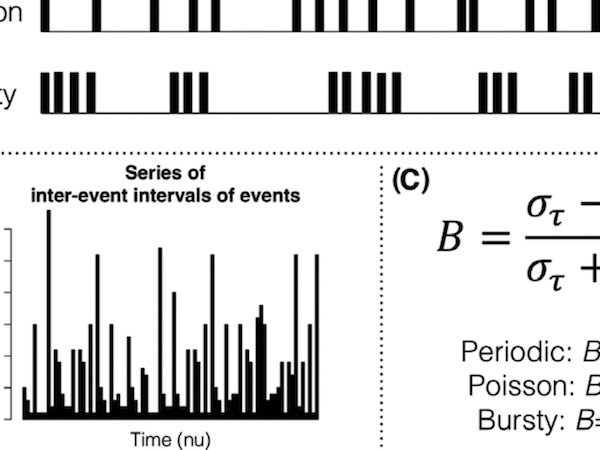
New paper: how "bursty" is communication?
Dr. Drew Abney leads a collaboration in which we show that verbal and non-verbal behaviors show distinct patterns of "burstiness": a statistical signature that reflects the "waves" of behavior that tend to structure our interactions. Read about it here. Abney, D. H., Dale, R., Kello, C. T. & Louwerse, M. M. (2018). The bursts and lulls of multimodal interaction: Temporal distributions of behavior reveal differences between verbal and non-verbal communication. Cognitive Science.
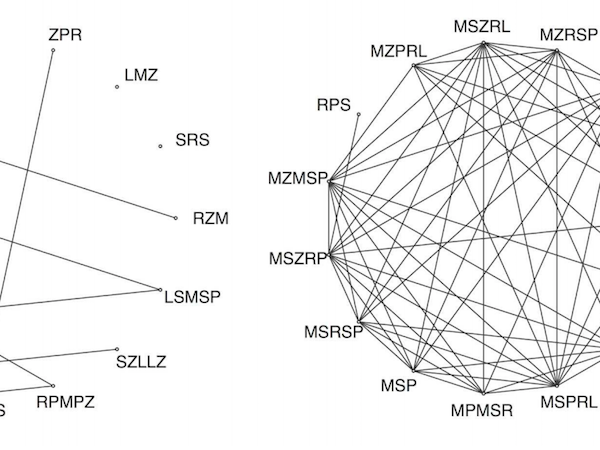
PLOS ONE paper: language structure could emerge from memory constraints
In a project led by Hannah Cornish, and in collaboration with Morten Christiansen and Simon Kirby, we contributed to analysis of an experiment showing that language-like behavior patterns might emerge from how memory constrains performance. This suggests that language's unique structure, often the subject of extensive theoretical debate, may emerge as a natural consequence of making sequences of stimuli more efficient for recall. Read about it here. Citation: Cornish, H., Dale, R., Kirby, S. & Christiansen, M. H. (2017). Sequence memory constraints give rise to language-like structure through iterated learning. PLOS ONE, 12, e0168532.
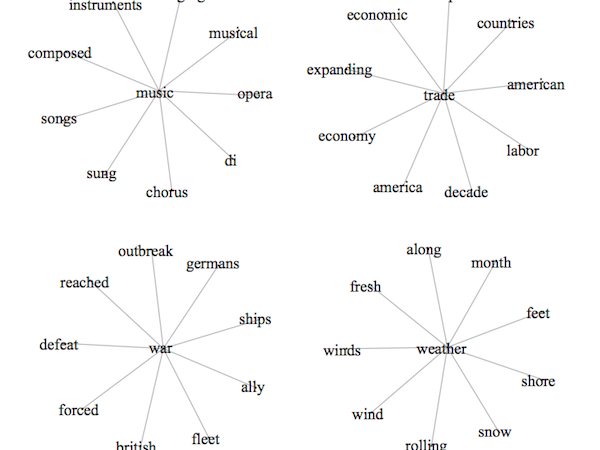
Google Ngram as a playground for developing tests of selection
UC Merced applied mathematics colleague Dr. Suzanne Sindi and the lab have used Google Ngram as a kind of arena in which to test out different ideas about behavioral selection. We analyzed 100 years of English from Google's data, showing that cultural patterns of change may be detectable using simple statistical techniques. Download it here. Citation: Sindi, S. & Dale, R. (2016). Culturomics as a data playground for tests of selection: mathematical approaches to detecting selection in word use. Journal of Theoretical Biology, 405, 140-149.
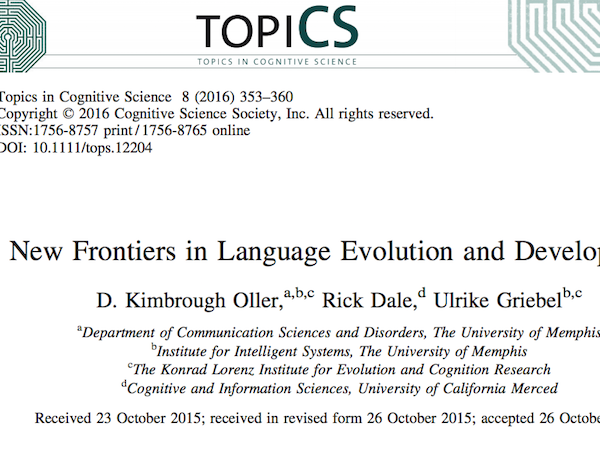
New frontiers in language evolution and development
With colleagues at The University of Memphis (Oller and Griebel), the Cognaction Lab was involved in organizing a workshop and special issue in new approaches to language evolution and development. The spring 2016 special issue was published in Topics in Cognitive Science, and you can view the lab's offerings in the special issue here.

Twitter and timescales of massive social attention
The Cognaction lab is part of a broad interdisciplinary team that recently time locked large amounts of Twitter mention data to the time course of the 2012 Presidential Debates. Results show that massive human entrainment takes place at a number of distinct time scales, led by Riccardo Fusaroli (Aarhus) and Marcus Perlman (Madison). The paper has now been accepted for publication at PLOS ONE: Fusaroli, R., Perlman, M., Mislove, A., Paxton, A., Matlock, T., & Dale, R. (2015). Timescales of massive human entrainment. PLOS ONE, 10, e0122742

Google Glass for studying interaction dynamics
The Cognaction Laboratory has started using Google Glass to study interaction, with an infrastructure we call PsyGlass (GitHub). With crucial help from skillful Android coding of the former EECS (and COGS minor) student Kevin Rodriguez (now at Facebook!), Alexandra Paxton and Rick Dale have begun to develop scripts that can manipulate the Glass display while people interact, all while collecting body motion data stored on the device. Paxton, A., Rodriguez, K., & Dale, R. (in press). PsyGlass: capitalizing on Google Glass for naturalistic data collection. Behavior Research Methods.
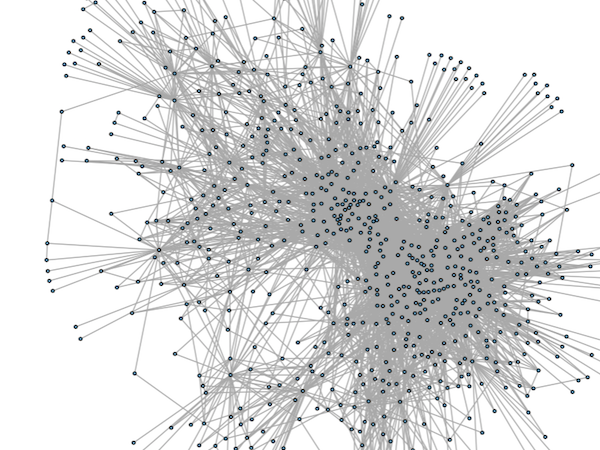
Cognaction PhD student wins IBM fellowship
Ph.D. student in the lab, David Vinson, has been awarded a prestigious IBM Ph.D. Fellowship. The award supports David for one academic year, and an opportunity to be mentored by an IBM scientist and participate in IBM’s research community, all while supporting his computational and cognitive research here in the lab. Part of Dave's project is to study the relationship between social structure and communication in communities. Read more here. You can also read about our Yelp Dataset Challenge award winning paper on the Yelp site, here.

Papers at CogSci 2014
Collaborations with lab students will be presented at Cognitive Science this year in Quebec City. Five 6-page proceedings papers were accepted in some form, and are cited below. Congrats students!
Paxton, A., & Dale, R. (2014). Leveraging linguistic content and debater traits to predict debate outcomes.
Paxton, A., Abney, D, Kello, C. T., & Dale, R. (2014). Network analysis of multimodal, multiscale coordination in dyadic problem solving.
Szary, J., & Dale, R. (2014). Collaborative memory constraints: Familiarity, cooperation, and individual skill.
Tabatabaeian, M., Dale, R., & Duran, N. (2014). Facilitation in dishonesty is subject to task constraints.
Vinson, D. W. & Dale, R. (2014). Valence weakly constrains the information density of messages.
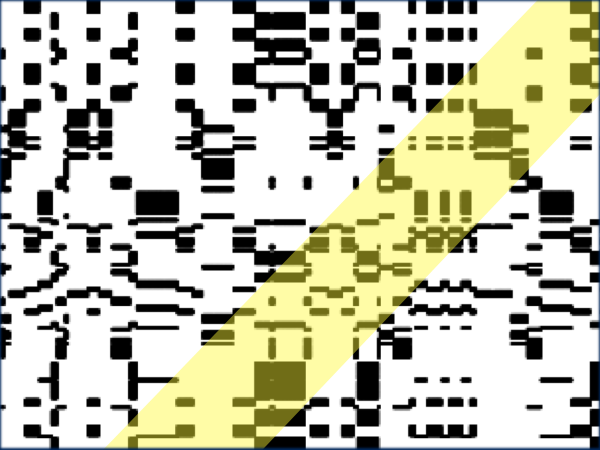
Lab involved in 2014 workshops
This year, methods the Cognaction lab uses will be featured in several workshops.
- In late April, Moreno Coco and Rick Dale will be presenting a workshop on recurrence quantification methods for language research, organized by Alessia Tosi, at the University of Edinburgh. Click here for details.
- In June, Joanna Rączaszek-Leonardi and Rick Dale will be presenting a one-day workshop on theory and methods for the study of linguistic interaction at the University of Connecticut, in conjunction with the Finding Common Ground conference organized by Bert Hodges and Carol Fowler.
- Later in June, Rick Dale will be participating again in APA's Advanced Training Institute on Nonlinear Methods for Psychological Science, organized by the illustrious Cincinnati Dynamics crew.

Arguments disrupts synchrony
Abstract Research on interpersonal convergence and synchrony characterizes the way in which interacting individuals come to have more similar affect, behaviour, and cognition over time. Although its dynamics have been explored in many settings, convergence during conflict has been almost entirely overlooked. We present a simple but ecologically valid study comparing how different situational contexts that highlight affiliation and argument impact interpersonal convergence of body movement and to what degree emotional states affect convergence in both conversational settings. Using linear mixed-effect models, we found that in-phase bodily synchrony decreases significantly during argument. However, affective changes did not significantly predict changes in levels of interpersonal synchrony, suggesting that differences in affect valences between affiliation and argument cannot solely explain our results.
Led by graduate student Alexandra Paxton
Paxton, A. & Dale, R. (2013). Argument disrupts interpersonal synchrony. Quarterly Journal of Experimental Psychology, 66, 2092-2102.

New CRQA library for R
Try out our new CRQA library in R! In a project led by Dr. Moreno Coco (lab visitor in 2012), we have put together a new and very efficient CRQA library for R (click here for the library, from Dr. Coco's website). Here is the abstract of our draft paper.
The paper is now posted on arXiv.org for feedback. Check it out here. If you find it useful, please cite:
Coco, M. I. & Dale, R. (2013). Cross-recurrence quantification analysis of categorical and continuous time series: an R package. arXiv: cs.CL/1310.0201.
Here's the abstract:
This paper describes the R package crqa to perform cross-recurrence quantification analysis of two time series of either a categorical or continuous nature. Streams of behavioral information, from eye movements to linguistic elements, unfold over time. When two people interact, such as in conversation, they often adapt to each other, leading these behavioral levels to exhibit recurrent states. In dialogue, for example, interlocutors adapt to each other by exchanging interactive cues: smiles, nods, gestures, choice of words, and so on. In order for us to capture closely the goings-on of dynamic interaction, and uncover the extent of coupling between two individuals, we need to quantify how much recurrence is taking place at these lev- els. Methods available in crqa would allow researchers in cognitive science to pose such questions as how much are two people recurrent at some level of analysis, what is the characteristic lag time for one person to maximally match another, or whether one person is leading another. First, we set the theoretical ground to un- derstand the difference between ‘correlation’ and ‘co-visitation’ when comparing two time series, using an aggregative or cross-recurrence approach. Then, we de- scribe more formally the principles of cross-recurrence, and show with the current package how to carry out analyses applying them. We end the paper by compar- ing computational efficiency, and results’ consistency, of crqa R package, with the benchmark MATLAB toolbox crptoolbox. We show perfect comparability be- tween the two libraries on both levels.

Coordination workshop at CogSci '13
Workshop Given at CogSci 2013 Humans interact with other humans. They do so frequently, in a wide variety of circumstances, to accomplish many different goals. This interpersonal interaction, especially in face-to-face circumstances, requires coordination (Clark, 1996). This involves many subtle behaviors, controlled carefully in the context of another person, from eye movements and gestures, to choice of words. The characteristics of the cognitive system that give way to this coordination have been a matter of debate recently in the cognitive sciences. Yet there remain many open questions about how the cognitive system functions in human interactions. How does interpersonal coordination emerge in the dyad? What behaviors are coordinated between persons, and in what manner? How can we model dyads and their interactions? ... Together these strands of research offer new insight into human social dynamics, and the means to implement and test theories in robotics and virtual agents. Bringing them together in one workshop is an opportunity to convey these new methods, and find shared interests and synergies among different approaches and different fields, These are the primary goals of the workshop.
Dale, R. (co-organizer), Yu, C. (co-organizer), Nagai, Y., Coco, M., & Kopp, S. (2013). Approaches to interpersonal coordination: infants, adults, robots, and agents. Proceedings of the 35th Annual Meeting of the Cognitive Science Society. (workshop)

Estimating decision surfaces
Abstract Within decisions, perceived alternatives compete until one is preferred. Across decisions, the playing field on which these alternatives compete evolves to favor certain alternatives. Mouse cursor trajectories provide rich continuous information related to such cognitive processes during decision making. In three experiments, participants learned to choose symbols to earn points in a discrimination learning paradigm and the cursor trajectories of their responses were recorded. Decisions between two choices that earned equally high-point rewards exhibited far less competition than decisions between choices that earned equally low-point rewards. Using positional coordinates in the trajectories, it was possible to infer a potential field in which the choice locations occupied areas of minimal potential. These decision spaces evolved through the experiments, as participants learned which options to choose. This visualisation approach provides a potential framework for the analysis of local dynamics in decision-making that could help mitigate both theoretical disputes and disparate empirical results.
Led by Dr. Denis O'Hora, NUI Galway.
O'Hora., D., Dale, R., Piiroinen, P., & Connolly, F. (2013). Local dynamics in decision making: The evolution of preference within and across decisions. Scientific Reports, 3, 2210. doi: 10.1038/srep02210

Issue in honor of Guy Van Orden
Guy Van Orden was a brilliant scientist and a generous collaborator. To honor his scientific contributions, Jay Holden, Heidi Kloos, Michael Richardson, and Rick Dale co-edited a special issue of Ecological Psychology. An array of commemorative papers presents a range of perspectives, empirical and theoretical, on the inspiring, caring, and provocative influence of Guy.
Dale, R., Holden, J., Kloos, H., & Richardson, M. J. (Eds., alphabetical) (2013). A cognitive science slam in honor of Guy Van Orden. Ecological Psychology, 25.
To see the Table of Contents of the issue, click here.

Collective cognitive systems?
Abstract Research on linguistic interaction suggests that two or more individuals can sometimes form adaptive and cohesive systems. We describe an “alignment system” as a loosely interconnected set of cognitive processes that facilitate social interactions. As a dynamic, multi-component system, it is responsive to higher-level cognitive states such as shared beliefs and intentions (those involving collective intentionality) but can also give rise to such shared cognitive states via bottom-up processes. As an example of putative group cognition we turn to transactive memory and suggest how further research on alignment in these cases might reveal how such systems can be genuinely described as cognitive. Finally, we address a prominent critique of collective cognitive systems, arguing that there is much empirical and explanatory benefit to be gained from considering the possibility of group cognitive systems, especially in the context of small-group human interaction.
And: "...we address concerns that might head this research program off at the pass by considering and responding to Rupert's (2011) recent criticisms of group cognition."
Tollefsen, D. P., Dale R., & Paxton, A. (2013). Alignment, transactive memory, and collective cognitive systems. Review of Philosophy and Psychology, 4, 49-64. doi: DOI 10.1007/s13164-012-0126-z
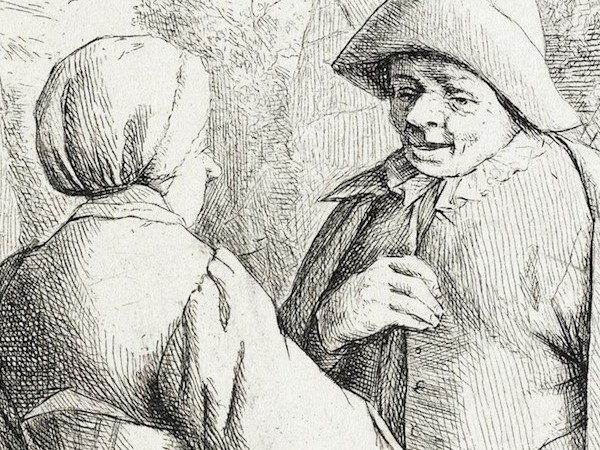
The Centipede's Dilemma
Abstract We describe a “centipede’s dilemma” that faces the sciences of human interaction. Research on human interaction has been involved in extensive theoretical debate, although the vast majority of research tends to focus on a small set of human behaviors, cognitive processes, and interactive contexts. The problem is that naturalistic human interaction must integrate all of these factors simultaneously, and grander theoretical mitigation cannot come only from focused experimental or computational agendas. We look to dynamical systems theory as a framework for thinking about how these multiple behaviors, processes, and contexts can be integrated into a broader account of human interaction. By introducing and utilizing basic concepts of self-organization and synergy, we review empirical work that shows how human interaction is flexible and adaptive and structures itself incrementally during unfolding interactive tasks, such as conversation, or more focused goal-based contexts. We end on acknowledging that dynamical systems accounts are very short on concrete models, and we briefly describe ways that theoretical frameworks could be integrated, rather than endlessly disputed, to achieve some success on the centipede’s dilemma of human interaction.
Dale, R., Fusaroli, R., Duran, N. D., & Richardson, D. C. (2013). The self-organization of human interaction. In B. Ross (Ed.),Psychology of Learning and Motivation, vol. 59 (pp. 43-95). Elsevier, Inc.: Academic Press.

Dynamics of perceptive-taking
Abstract We present a dynamical systems account of how simple social information influences perspective-taking. Our account is motivated by the notion that perspective-taking may obey common dynamic principles with perceptuomotor coupling. We turn to the prominent HKB dynamical model of motor coordination, drawing from basic principles of self-organization to describe how conversational perspective-taking unfolds in a lowdimensional attractor landscape. We begin by simulating experimental data taken from a simple instruction-following task, in which participants have different expectations about their interaction partner. By treating belief states as different values of a control parameter, we show that data generated by a basic dynamical process fits overall egocentric and other-centric response distributions, the time required for participants to enact a response on a trial-by-trial basis, and the action dynamics exhibited in individual trials. We end by discussing the theoretical significance of dynamics in dialog, arguing that high-level coordination such as perspective-taking may obey similar dynamics as perceptuomotor coordination, pointing to common principles of adaptivity and flexibility during dialog.
Led by Dr. Nick Duran, ASU.
Duran, N. D. & Dale, R. (in press). Perspective-taking in dialogue as self-organization under social constraints. New Ideas in Psychology.

Interactive bodily synchrony
Abstract The study of interpersonal synchrony examines how interacting individuals grow to have similar behavior, cognition, and emotion in time. Many of the established methods of analyzing interpersonal synchrony are costly and timeconsuming; the study of bodily synchrony has been especially laborious, traditionally requiring researchers to hand-code movement frame by frame. Because of this, researchers have been searching for more efficient alternatives for decades. Recently, some researchers (e.g., Nagaoka & Komori (IEICE Transactions on Information and Systems, 91(6), 1634–1640, 2008); Ramseyer & Tschacher, 2008) have applied computer science and computer vision techniques to create framedifferencing methods (FDMs) to simplify analyses. In this article, we provide a detailed presentation of one such FDM, created by modifying and adding to existing FDMs. The FDM that we present requires little programming experience or specialized equipment: Only a few lines of MATLAB code are required to execute an automated analysis of interpersonal synchrony. We provide sample code and demonstrate its use with an analysis of brief, friendly conversations; using linear mixed-effects models, the measure of interpersonal synchrony was found to be significantly predicted by time lag (p < .001) and by the interaction between time lag and measures of interpersonal liking (p < .001). This pattern of results fits with existing literature on synchrony. We discuss the current limitations and future directions for FDMs, including their use as part of a larger methodology for capturing and analyzing multimodal interaction.
Led by Ph.D. student Alexandra Paxton.
Paxton, A., & Dale, R. (2013). Frame-differencing methods for measuring bodily synchrony in conversation. Behavior Research Methods, 45, 329-343. doi: 10.3758/s13428-012-0249-2

The linguistic niche hypothesis
Abstract Human language is unparalleled in both its expressive capacity and its diversity. What accounts for the enormous diversity of human languages? Recent evidence suggests that the structure of languages may be shaped by the social and demographic environment in which the languages are learned and used. In an analysis of over 2000 languages Lupyan and Dale demonstrated that socio-demographic variables, such as population size, significantly predicted the complexity of inflectional morphology. Languages spoken by smaller populations tend to employ more complex inflectional systems. Languages spoken by larger populations tend to avoid complex morphological paradigms, employing lexical constructions instead. This relationship may exist because of how language learning takes place in these different social contexts. In a smaller population, a tightly-knit social group combined with exclusive or almost exclusive language acquisition by infants permits accumulation of complex inflectional forms. In larger populations, adult language learning and more extensive cross-group interactions produce pressures that lead to morphological simplification. In the current paper, we explore this learning-based hypothesis in two ways. First, we develop an agent-based simulation that serves as a simple existence proof: As adult interaction increases, languages lose inflections. Second, we carry out a correlational study showing that English-speaking adults who had more interaction with non-native speakers as children showed a relative preference for over-regularized (i.e. morphologically simpler) forms. The results of the simulation and experiment lend support to the linguistic niche hypothesis: Languages may vary in the ways they do in part due to different social environments in which they are learned and used. In short, languages adapt to the learning constraints and biases of their learners.
Dale, R. & Lupyan, G. (2012). Understanding the origins of morphological diversity: the linguistic niche hypothesis. Advances in Complex Systems, 15(3-4), 1150017. (special issue on language dynamics)

A pluralist cognitive science
Abstract A case for a pluralistic approach to cognitive science is sketched. It is argued that cognitive scientists should take seriously the possibility that a single, unified framework for all of cognition is an unrealistic expectation for its diverse interdisciplinary goals and subject matter. A pluralistic approach instead seeks ways of integrating the multiple perspectives that have provided explanatory success in loosely interconnected sub-domains of cognitive phenomena. Research strategies recommended by this approach are discussed, with review of research currently carrying out such strategies and others that may hold promise for the future. The article ends with a discussion of seeking closer integration of the inquirer into consideration of which explanatory framework to choose. A systematic exploration of this transactional approach to cognitive science may grant coherence to pluralism even as it embraces diverse schemes of explanation.
Dale, R. (2008). The possibility of a pluralist cognitive science. Journal of Experimental and Theoretical Artificial Intelligence, 20, 155-179.
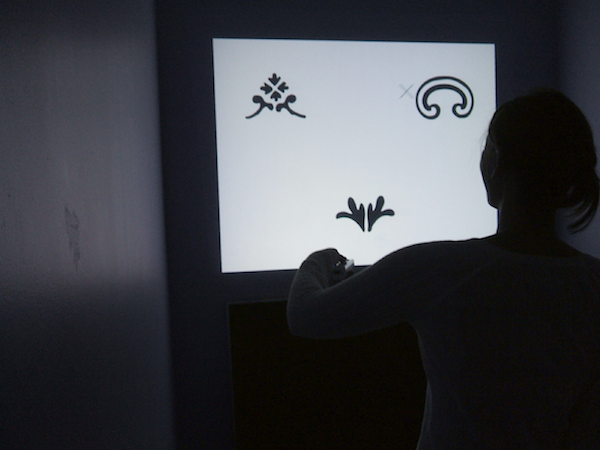
Action reveals learning
Abstract Much evidence exists supporting a richer interaction between cognition and action than commonly assumed. Such findings demonstrate that short-timescale processes, such as motor execution, may relate in systematic ways to longer-timescale cognitive processes, such as learning. We further substantiate one direction of this interaction: the flow of cognition into action systems. Two experiments explored match-to-sample paired-associate learning, in which participants learned randomized pairs of unfamiliar symbols. During the experiments, their hand movements were continuously tracked using the Nintendo Wiimote. Across learning, participant arm movements are initiated and completed more quickly, exhibit lower fluctuation, and exert more perturbation on the Wiimote during the button press. A second experiment demonstrated that action dynamics index novel learning scenarios, and not simply acclimatization to the Wiimote interface. Results support a graded and systematic covariation between cognition and action, and recommend ways in which this theoretical perspective may contribute to applied learning contexts.
Dale, R., Roche, J. M., Snyder, K., & McCall, R. (2008). Exploring action dynamics as an index of paired-associate learning.PLoS ONE, 3, e1728. doi:10.1371/journal.pone.0001728